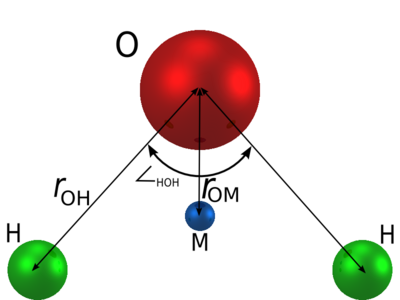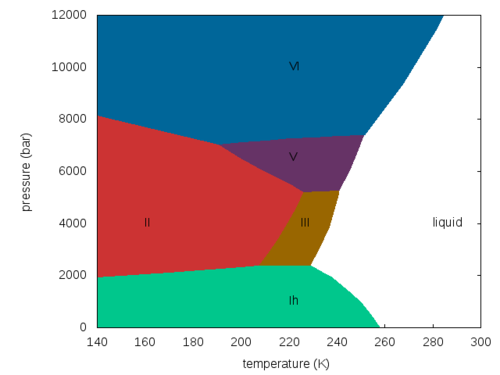TIP4PQ/2005 model of water: Difference between revisions
Jump to navigation
Jump to search
Carl McBride (talk | contribs) (New page: The '''TIP4PQ/2005''' model <ref>[http://arxiv.org/abs/0906.3967 Carl McBride, Carlos Vega, Eva G. Noya, Rafael Ramirez, Luis M. Sese "Quantum contributions in the ice phases: the path to ...) |
Carl McBride (talk | contribs) m (→Phase diagram: Added volume and page numbers) |
||
| (8 intermediate revisions by 2 users not shown) | |||
| Line 1: | Line 1: | ||
The '''TIP4PQ/2005''' model | The '''TIP4PQ/2005''' model | ||
<ref>[http:// | <ref>[http://dx.doi.org/10.1063/1.3175694 Carl McBride, Carlos Vega, Eva G. Noya, Rafael Ramirez, Luis M. Sese "Quantum contributions in the ice phases: the path to a new empirical model for water -- TIP4PQ/2005", Journal of Chemical Physics '''131''' 024506 (2009)]</ref> | ||
is a re-parameterisation of the [[TIP4P/2005]] potential for [[Path integral formulation |quantum path integral simulations]] of [[water]], in particular for the [[ice phases]]. | is a re-parameterisation of the [[TIP4P/2005]] potential for [[Path integral formulation |quantum path integral simulations]] of [[water]], in particular for the [[ice phases]]. | ||
TIP4P/2005 is | The difference between the TIP4P/2005 and the TIP4PQ/2005 models is the [[dipole moment]], which increases from 2.305D to 2.38D thanks to the difference in the | ||
charges: TIP4P/2005 q(H) (e) is 0.5564 whereas for the TIP4PQ/2005 model this becomes 0.5764e. | |||
==Parameters== | ==Parameters== | ||
[[Image:Four_site_water_model.png|center|400px]] | [[Image:Four_site_water_model.png|center|400px]] | ||
| Line 13: | Line 14: | ||
| 0.9572 || 104.52 || 3.1589 || 93.2 || 0 || 0.5764 || -2q(H) || 0.1546 | | 0.9572 || 104.52 || 3.1589 || 93.2 || 0 || 0.5764 || -2q(H) || 0.1546 | ||
|} | |} | ||
==Phase diagram== | |||
The [[Phase diagrams | phase diagram]] of the TIP4PQ/2005 model in the [[Phase diagrams: Pressure-temperature plane |pressure-temperature plane]] (adapted from Fig. 3 of <ref>[http://dx.doi.org/10.1039/C2CP40962C Carl McBride, Eva G. Noya, Juan L. Aragones, Maria M. Conde and Carlos Vega "The phase diagram of water from quantum simulations", Physical Chemistry Chemical Physics '''14''' pp. 10140-10146 (2012)]</ref>) | |||
:[[Image:TIP4PQ_2005_phase_diagram.png|500px]] | |||
==Density maximum== | |||
The TIP4PQ/2005 model has a [[Liquid phase density maximum | density maximum in the liquid phase]] at 280K <ref>[http://dx.doi.org/10.1063/1.3239471 E. G. Noya, C. Vega, L. M. Sesé, and R. Ramírez "Quantum effects on the maximum in density of water as described by the TIP4PQ/2005 model", Journal of Chemical Physics '''131''' 124518 (2009)]</ref>. | |||
==References== | ==References== | ||
<references/> | <references/> | ||
'''Related reading''' | |||
*[http://dx.doi.org/10.1063/1.3298879 C. Vega, M. M. Conde, C. McBride, J. L. F. Abascal, E. G. Noya, R. Ramirez, and L. M. Sesé "Heat capacity of water: A signature of nuclear quantum effects", Journal of Chemical Physics '''132''' 046101 (2010)] | |||
*[http://dx.doi.org/10.1021/jp910770y Briesta S. González, Eva G. Noya, Carlos Vega and Luis M. Sesé "Nuclear Quantum Effects in Water Clusters: The Role of the Molecular Flexibility", Journal of Physical Chemistry B (Article ASAP) (2010)] | |||
[[Category: Water]] | [[Category: Water]] | ||
[[Category: Models]] | [[Category: Models]] | ||
{{numeric}} | {{numeric}} | ||
Latest revision as of 10:24, 4 July 2012
The TIP4PQ/2005 model [1] is a re-parameterisation of the TIP4P/2005 potential for quantum path integral simulations of water, in particular for the ice phases. The difference between the TIP4P/2005 and the TIP4PQ/2005 models is the dipole moment, which increases from 2.305D to 2.38D thanks to the difference in the charges: TIP4P/2005 q(H) (e) is 0.5564 whereas for the TIP4PQ/2005 model this becomes 0.5764e.
Parameters[edit]

| (Å) | HOH , deg | (Å) | (K) | q(O) (e) | q(H) (e) | q(M) (e) | (Å) |
| 0.9572 | 104.52 | 3.1589 | 93.2 | 0 | 0.5764 | -2q(H) | 0.1546 |
Phase diagram[edit]
The phase diagram of the TIP4PQ/2005 model in the pressure-temperature plane (adapted from Fig. 3 of [2])
Density maximum[edit]
The TIP4PQ/2005 model has a density maximum in the liquid phase at 280K [3].
References[edit]
- ↑ Carl McBride, Carlos Vega, Eva G. Noya, Rafael Ramirez, Luis M. Sese "Quantum contributions in the ice phases: the path to a new empirical model for water -- TIP4PQ/2005", Journal of Chemical Physics 131 024506 (2009)
- ↑ Carl McBride, Eva G. Noya, Juan L. Aragones, Maria M. Conde and Carlos Vega "The phase diagram of water from quantum simulations", Physical Chemistry Chemical Physics 14 pp. 10140-10146 (2012)
- ↑ E. G. Noya, C. Vega, L. M. Sesé, and R. Ramírez "Quantum effects on the maximum in density of water as described by the TIP4PQ/2005 model", Journal of Chemical Physics 131 124518 (2009)
Related reading
- C. Vega, M. M. Conde, C. McBride, J. L. F. Abascal, E. G. Noya, R. Ramirez, and L. M. Sesé "Heat capacity of water: A signature of nuclear quantum effects", Journal of Chemical Physics 132 046101 (2010)
- Briesta S. González, Eva G. Noya, Carlos Vega and Luis M. Sesé "Nuclear Quantum Effects in Water Clusters: The Role of the Molecular Flexibility", Journal of Physical Chemistry B (Article ASAP) (2010)





